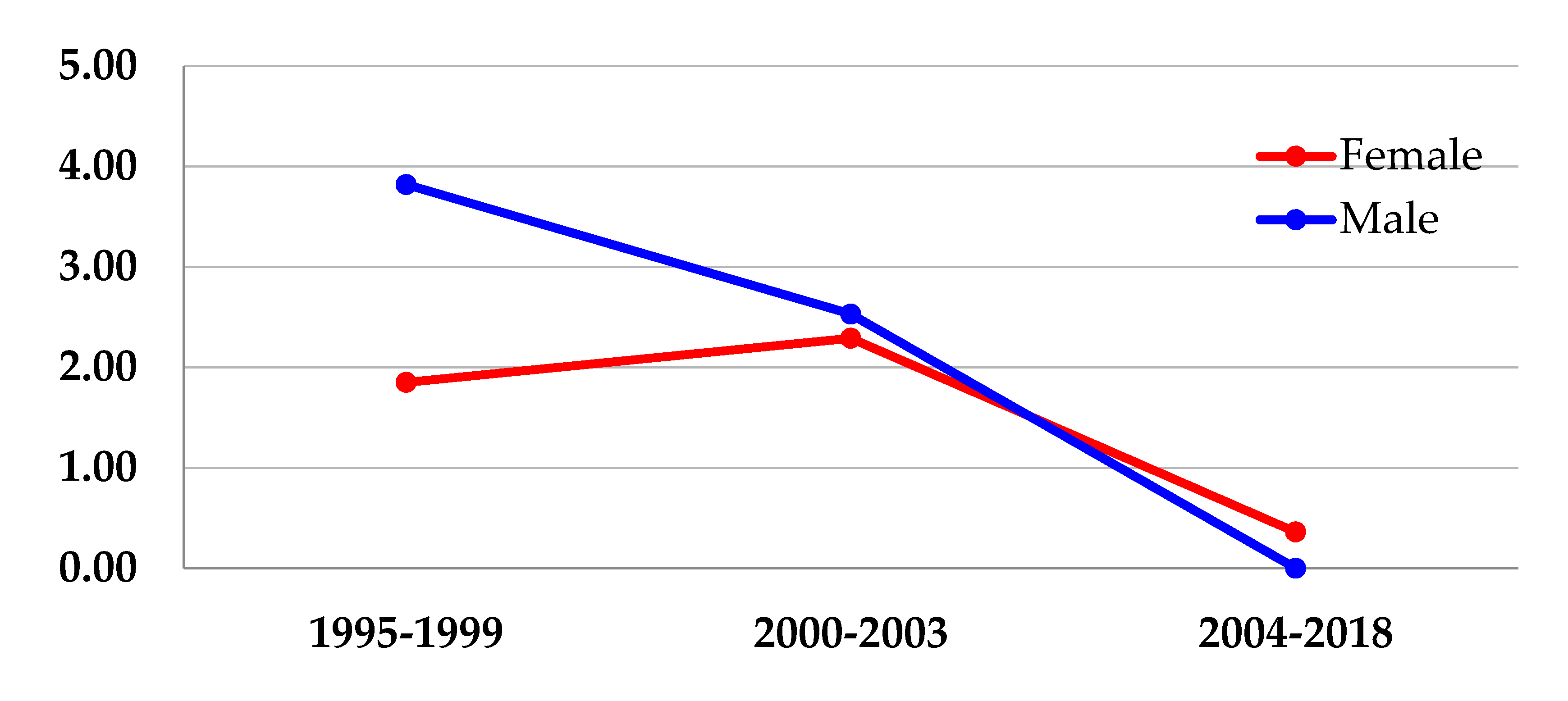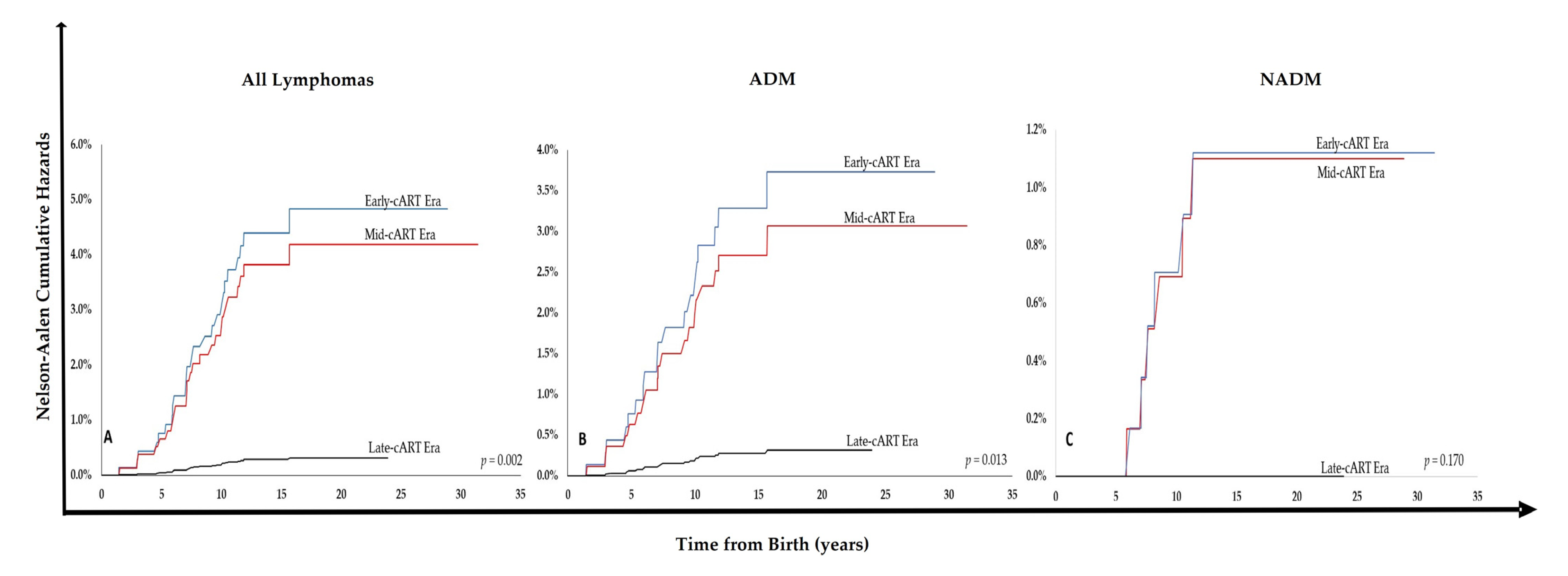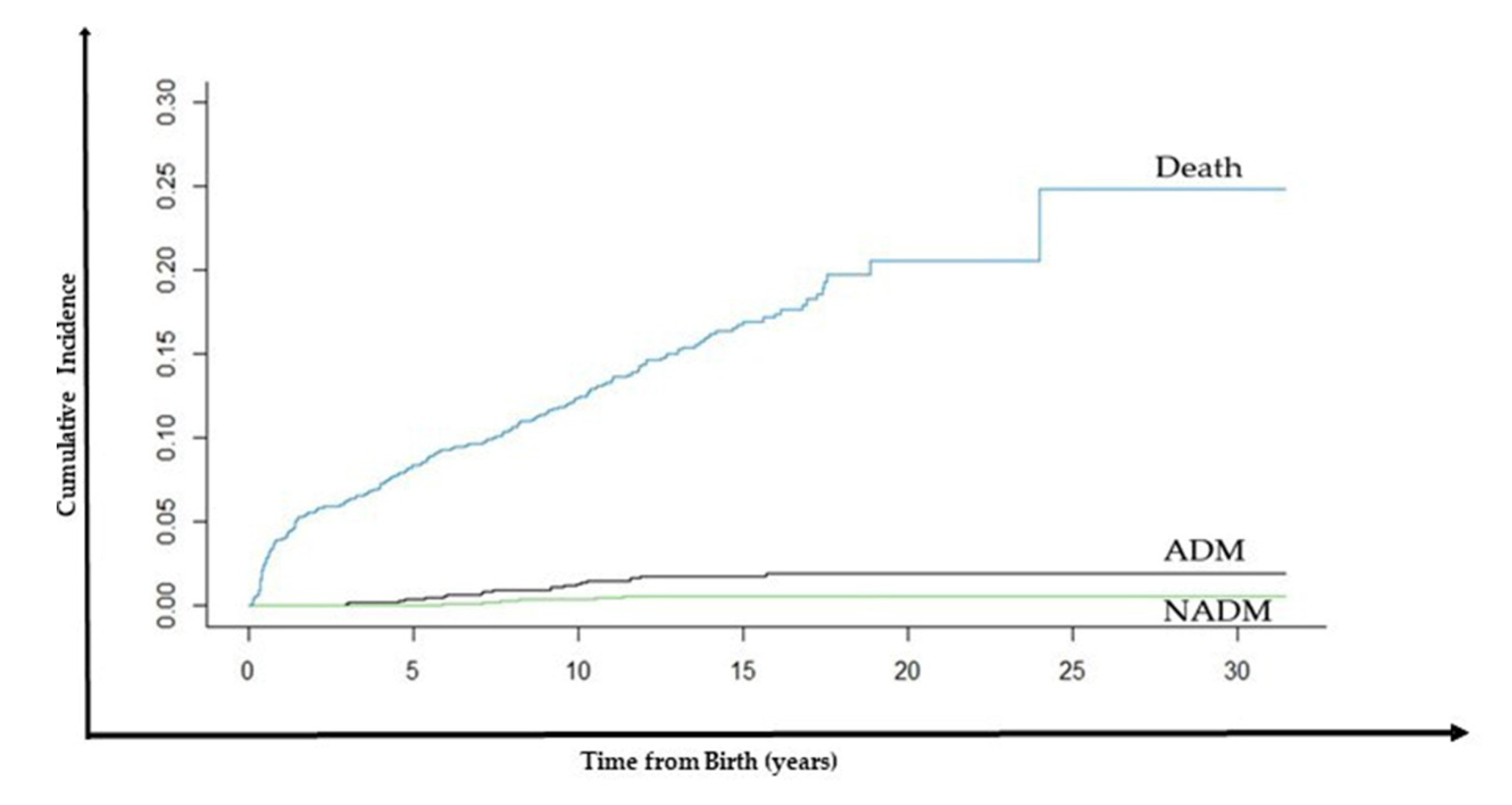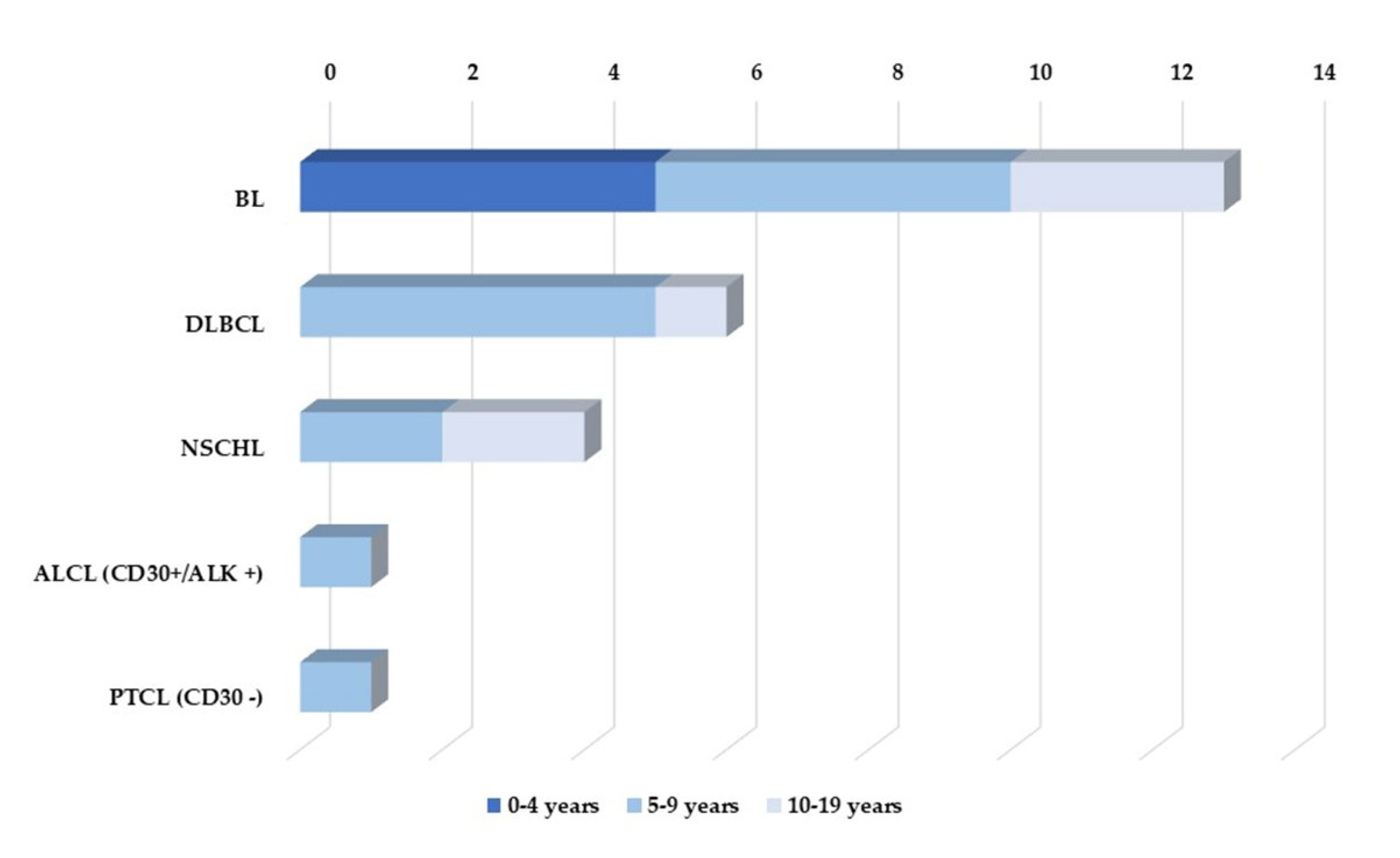Incidence and Clinical Description of Lymphomas in Children and Adolescents with Vertical Transmission of HIV in Rio de Janeiro, Brazil, in Pre- and Post-Combined Antiretroviral Therapy Eras: A Multicentric Hospital-Based Survival Analysis Study
Abstract
Simple Summary
Abstract
1. Introduction
2. Materials and Methods
2.1. Study Design, Study Populations, and Data
2.2. Study Period Definition
2.3. Tumor Samples and Laboratorial Analysis
2.4. Outcome Variables and Definition
2.5. Statistical Analysis
3. Results
3.1. Characteristics of the Study Population and Incidence of Lymphoma in CLWH
3.2. Evolution of Lymphoma Diagnosis in HIV-Vertically Infected Children
3.3. Competing Risk of Developing Lymphoma and for Death Not Related to Lymphoma per Eras
3.4. Subtypes of Lymphomas Found in the Cohort
4. Discussion
5. Conclusions
Author Contributions
Funding
Institutional Review Board Statement
Informed Consent Statement
Data Availability Statement
Acknowledgments
Conflicts of Interest
References
- Caselli, D.; Klersy, C.; de Martino, M.; Gabiano, C.; Galli, L.; Tovo, P.; Aricò, M.; Italian register for HIV infection in children. Human immunodeficiency virus–related cancer in children: Incidence and treatment outcome—Report of the Italian register. J. Clin. Oncol. 2000, 18, 3854–3861. [Google Scholar] [CrossRef] [PubMed]
- Granovsky, M.O.; Mueller, B.U.; Nicholson, H.S.; Rosenberg, P.S.; Rabkin, C.S. Cancer in human immunodeficiency virus-infected children: A case series from the Children’s Cancer Group and the National Cancer Institute. J. Clin. Oncol. 1998, 16, 1729–1735. [Google Scholar] [CrossRef] [PubMed]
- Wilmshurst, J.M.; Hammond, C.K.; Donald, K.; Hoare, J.; Cohen, K.; Eley, B. NeuroAIDS in children. Handb. Clin. Neurol. 2018, 152, 99–116. [Google Scholar] [PubMed]
- Besson, C.; Goubar, A.; Gabarre, J.; Rozenbaum, W.; Pialoux, G.; Châtelet, F.-P.; Katlama, C.; Charlotte, F.; Dupont, B.; Brousse, N.; et al. Changes in AIDS-related lymphoma since the era of highly active antiretroviral therapy. Blood J. Am. Soc. Hematol. 2001, 98, 2339–2344. [Google Scholar] [CrossRef] [PubMed]
- Hessol, N.A.; Whittemore, H.; Vittinghoff, E.; Hsu, L.C.; Ma, D.; Scheer, S.; Schwarcz, S.K. Incidence of first and second primary cancers diagnosed among people with HIV, 1985–2013: A population-based, registry linkage study. Lancet HIV 2018, 5, e647–e655. [Google Scholar] [CrossRef]
- Shiels, M.S.; Pfeiffer, R.M.; Gail, M.H.; Hall, H.I.; Li, J.; Chaturvedi, A.K.; Bhatia, K.; Uldrick, T.S.; Yarchoan, R.; Goedert, J.J.; et al. Cancer burden in the HIV-infected population in the United States. Gynecol. Oncol. 2011, 103, 753–762. [Google Scholar] [CrossRef] [PubMed]
- Smith, C.J.; Ryom, L.; Weber, R.; Morlat, P.; Pradier, C.; Reiss, P.; Kowalska, J.D.; de Wit, S.; Law, M.; el Sadr, W.; et al. Trends in underlying causes of death in people with HIV from 1999 to 2011 (D:A:D): A multicohort collaboration. Lancet 2014, 384, 241–248. [Google Scholar] [CrossRef]
- Pollock, B.H.; Jenson, H.; Leach, C.T.; McClain, K.; Hutchison, R.E.; Garzarella, L.; Joshi, V.V.; Parmley, R.T.; Murphy, S.B. Risk factors for pediatric human immunodeficiency virus–related malignancy. JAMA 2003, 289, 2393–2399. [Google Scholar] [CrossRef]
- Chiappini, E.; Berti, E.; Gianesin, K.; Petrara, M.R.; Galli, L.; Giaquinto, C.; de Martino, M.; De Rossi, A. Pediatric human immunodeficiency virus infection and cancer in the highly active antiretroviral treatment (HAART) era. Cancer Lett. 2014, 347, 38–45. [Google Scholar] [CrossRef]
- Zicari, S.; Sessa, L.; Cotugno, N.; Ruggiero, A.; Morrocchi, E.; Concato, C.; Rocca, S.; Zangari, P.; Manno, E.C.; Palma, P. Immune activation, inflammation, and non-AIDS co-morbidities in HIV-infected patients under long-term ART. Viruses 2019, 11, 200. [Google Scholar] [CrossRef]
- Shindiapina, P.; Ahmed, E.H.; Mozhenkova, A.; Abebe, T.; Baiocchi, R.A. Immunology of EBV-related lymphoproliferative disease in HIV-positive individuals. Front. Oncol. 2020, 10, 1723. [Google Scholar] [CrossRef]
- Verdu-Bou, M.; Tapia, G.; Hernandez-Rodriguez, A.; Navarro, J.-T. Clinical and Therapeutic Implications of Epstein–Barr Virus in HIV-Related Lymphomas. Cancers 2021, 13, 5534. [Google Scholar] [CrossRef]
- Hatano, Y.; Ideta, T.; Hirata, A.; Hatano, K.; Tomita, H.; Okada, H.; Shimizu, M.; Tanaka, T.; Hara, A. Virus-driven carcinogenesis. Cancers 2021, 13, 2625. [Google Scholar] [CrossRef] [PubMed]
- Centers for Disease Control and Prevention. Revised classification system for human immunodeficiency virus infection in children less than 13 years of age. Morb. Mortal. Wkly. Rep. 1994, 43, 1–10. [Google Scholar]
- Simard, E.P.; Shiels, M.S.; Bhatia, K.; Engels, E.A. Long-term Cancer Risk among People Diagnosed with AIDS during Childhood Cancers among People Diagnosed with AIDS during Childhood. Cancer Epidemiol. Biomark. Prev. 2012, 21, 148–154. [Google Scholar] [CrossRef]
- Carbone, A.; Vaccher, E.; Gloghini, A. Hematologic cancers in individuals infected by HIV. Blood 2022, 139, 995–1012. [Google Scholar] [CrossRef]
- Chiappini, E.; Galli, L.; Tovo, P.-A.; Gabiano, C.; Lisi, C.; Giaquinto, C.; Rampon, O.; Gattinara, G.C.; De Marco, G.; Osimani, P.; et al. Cancer rates after year 2000 significantly decrease in children with perinatal HIV infection: A study by the Italian Register for HIV Infection in Children. J. Clin. Oncol. 2007, 25, 97–101. [Google Scholar] [CrossRef] [PubMed]
- THE Global Alliance. Global Alliance to end AIDS in Children. 2022. Available online: https://www.childrenandaids.org/global-alliance (accessed on 15 October 2022).
- UNAIDS. Fact Sheet 2022. 2022. Available online: https://unaids.org.br/wp-content/uploads/2022/07/2022_07_27_Factsheet_PT.pdf (accessed on 15 October 2022).
- BRASIL. Boletim Epidemiológico. Secretaria de Vigilância em Saúde. 2021. Available online: https://www.gov.br/saude/pt-br/centrais-de-conteudo/publicacoes/boletins/epidemiologicos/especiais/2021/boletim-epidemiologico-especial-hiv-aids-2021.pdf (accessed on 15 October 2022).
- Rabkin, C. AIDS and cancer in the era of highly active antiretroviral therapy (HAART). Eur. J. Cancer 2001, 37, 1316–1319. [Google Scholar] [CrossRef]
- Chiappini, E.; Larotonda, F.; Lisi, C.; Giacomet, V.; Erba, P.; Bernardi, S.; Zangari, P.; Di Biagio, A.; Taramasso, L.; Giaquinto, C.; et al. Real-world analysis of survival and clinical events in a cohort of Italian perinatally HIV-1 infected children from 2001 to 2018. Front. Pediatr. 2021, 9, 665764. [Google Scholar] [CrossRef]
- Borges, H.; Neuhaus, J.; Babiker, A.G.; Henry, K.; Jain, M.K.; Palfreeman, A.; Mugyenyi, P.; Domingo, P.; Hoffmann, C.; Read, T.R.H.; et al. Immediate antiretroviral therapy reduces risk of infection-related cancer during early HIV infection. Clin. Infect. Dis. 2016, 63, 1668–1676. [Google Scholar] [CrossRef] [PubMed]
- Haq, H.; Elyanu, P.; Bulsara, S.; Bacha, J.; Campbell, L.; El-Mallawany, N.; Keating, E.; Kisitu, G.; Mehta, P.; Rees, C.; et al. Association between antiretroviral therapy and cancers among children living with HIV in sub-Saharan Africa. Cancers 2021, 13, 1379. [Google Scholar] [PubMed]
- Szwarcwald, C.L.; De Castilho, E.A. The HIV/AIDS epidemic in Brazil: Three decades. Cad Saúde Pública 2011, 27, s4–s5. [Google Scholar] [CrossRef] [PubMed]
- Grinsztejn, B.; Luz, P.M.; Pacheco, A.G.; Santos, D.V.G.; Velasque, L.; Moreira, R.I.; Guimarães, M.R.C.; Nunes, E.P.; Lemos, A.S.; Ribeiro, S.R.; et al. Changing mortality profile among HIV-infected patients in Rio de Janeiro, Brazil: Shifting from AIDS to Non-AIDS related conditions in the HAART era. PLoS ONE 2013, 8, e59768. [Google Scholar] [CrossRef] [PubMed]
- Pacheco, A.G.; Tuboi, S.H.; Faulhaber, J.C.; Harrison, L.H.; Schechter, M. Increase in non-AIDS related conditions as causes of death among HIV-infected individuals in the HAART era in Brazil. PLoS ONE 2008, 3, e1531. [Google Scholar] [CrossRef] [PubMed][Green Version]
- de Martino, M.; Tovo, P.A.; Balducci, M.; Galli, L.; Gabiano, C.; Rezza, G.; Pezzotti, P.; Italian Register for HIV Infection in Children. Reduction in mortality with availability of antiretroviral therapy for children with perinatal HIV-1 infection. JAMA 2000, 284, 190–197. [Google Scholar] [CrossRef] [PubMed]
- Álvaro-Meca, A.; Micheloud, D.; Jensen, J.; Díaz, A.; García-Alvarez, M.; Resino, S. Epidemiologic trends of cancer diagnoses among HIV-infected children in Spain from 1997 to 2008. Pediatr. Infect. Dis. J. 2011, 30, 764–768. [Google Scholar] [CrossRef] [PubMed]
- Singh, E.; Naidu, G.; Davies, M.-A.; Bohlius, J. HIV-associated malignancies in children. Curr. Opin. HIV AIDS 2017, 12, 77–83. [Google Scholar] [CrossRef]
- BRASIL. Ministério da Saúde. Protocolo Clínico e Diretrizes Terapêuticas para Manejo da Infecção pelo HIV em Crianças e Adolescentes—Brasília: Ministério da Saúde, 2018. Available online: https://www.gov.br/aids/pt-br/centrais-de-conteudo/pcdts/2017/hiv-aids/pcdt_crianca_adolescentel_04_2019_web.pdf/view (accessed on 15 October 2022).
- Khoury, J.D.; Solary, E.; Abla, O.; Akkari, Y.; Alaggio, R.; Apperley, J.F.; Bejar, R.; Berti, E.; Busque, L.; Chan, J.K.C.; et al. The 5th edition of the World Health Organization classification of haematolymphoid tumours: Myeloid and histiocytic/dendritic neoplasms. Leukemia 2022, 36, 1703–1719. [Google Scholar] [CrossRef] [PubMed]
- WHO ICD 11. 2022. Available online: https://www.who.int/standards/classifications/classification-of-diseases (accessed on 15 October 2022).
- Scrucca, L.; Santucci, A.; Aversa, F. Regression modeling of competing risk using R: An in depth guide for clinicians. Bone Marrow Transplant. 2010, 45, 1388–1395. [Google Scholar] [CrossRef]
- Ponnuraja, C.; Valarmathi, S.; Lakshmanan, B.C.; Venkatesan, P. Survival Modeling of Competing Risk Using R: An Undemanding Simulation Approach. Int. J. Comp. Sci. Technol. 2014, 5, 434–439. [Google Scholar]
- Heinze, G.; Schemper, M. A solution to the problem of monotone likelihood in Cox regression. Biometrics 2001, 57, 114–119. [Google Scholar] [CrossRef]
- da Silva, W.F.; Garibaldi, P.M.M.; Da Rosa, L.I.; Bellesso, M.; Clé, D.V.; Delamain, M.T.; Rego, E.M.; Pereira, J.; Rocha, V. Outcomes of HIV-associated Burkitt Lymphoma in Brazil: High treatment toxicity and refractoriness rates—A multicenter cohort study. Leuk. Res. 2020, 89, 106287. [Google Scholar] [CrossRef]
- Elizabeth, C. Malignancies among children and young people with HIV in Western and Eastern Europe and Thailand. AIDS 2021, 35, 1973. [Google Scholar]
- Castilho, J.L.; Luz, P.M.; Shepherd, B.E.; Turner, M.; Ribeiro, S.R.; Bebawy, S.S.; Netto, J.S.; McGowan, C.C.; Veloso, V.G.; Engels, E.A.; et al. HIV and cancer: A comparative retrospective study of Brazilian and U.S. clinical cohorts. Infect. Agents Cancer 2015, 10, 4. [Google Scholar] [CrossRef]
- Rabie, H.; Maskew, M.; Bohlius, J.; Poole, J.; Davidson, A.; Prozesky, H.; Stefan, D.C.; Sawry, S.; Spoerri, A.; Maxwell, N.; et al. Incidence of AIDS-defining and other cancers in HIV-positive children in South Africa: Record linkage study. Pediatr. Infect. Dis. J. 2016, 35, e164. [Google Scholar]
- Kaatsch, P. Epidemiology of childhood cancer. Cancer Treat. Rev. 2010, 36, 277–285. [Google Scholar] [CrossRef] [PubMed]
- Bordoni, A.; Franceschi, S.; Lise, M.; Ledergerber, B.; Maso, L.D.; Clifford, G.M.; Bouchardy, C.; Ess, S.; Rickenbach, M.; Furrer, H.; et al. Changing patterns of cancer incidence in the early-and late-HAART periods: The Swiss HIV Cohort Study. Br. J. Cancer 2010, 103, 416–422. [Google Scholar]
- Hleyhel, M.; Belot, A.; Bouvier, A.M.; Tattevin, P.; Pacanowski, J.; Genet, P.; De Castro, N.; Berger, J.-L.; Dupont, C.; Lavolé, A.; et al. Risk of AIDS-defining cancers among HIV-1–infected patients in france between 1992 and 2009: Results from the FHDH-ANRS CO4 cohort. Clin. Infect. Dis. 2013, 57, 1638–1647. [Google Scholar] [CrossRef] [PubMed]
- Stefan, D.C.; Stones, D.K. Children with cancer and HIV infection: What is different about them? J. Pediatr. Hematol. Oncol. 2013, 35, 590–596. [Google Scholar] [CrossRef]
- Franzetti, M.; Ricci, E.; Bonfanti, P. The Pattern of non-AIDS-defining cancers in the HIV population: Epidemiology, risk factors and prognosis. A review. Curr. HIV Res. 2019, 17, 1–12. [Google Scholar] [CrossRef]
- Matida, L.H.; Ramos, A.N., Jr.; Heukelbach, J.; Sañudo, A.; Succi, R.C.D.M.; Marques, H.H.D.S.; Della Negra, M.; Hearst, N. Improving survival in children with AIDS in Brazil: Results of the second national study, 1999-2002. Cad Saúde Pública 2011, 27, s93–s103. [Google Scholar] [CrossRef] [PubMed][Green Version]
- Hacker, M.A.; Kaida, A.; Hogg, R.S.; Bastos, F.I. The first ten years: Achievements and challenges of the Brazilian program of universal access to HIV/AIDS comprehensive management and care, 1996-2006. Cad Saúde Pública 2007, 23, S345–S359. [Google Scholar] [CrossRef] [PubMed]
- Mills, E.J.; Nachega, J.B.; Bangsberg, D.R.; Singh, S.; Rachlis, B.; Wu, P.; Wilson, K.; Buchan, I.; Gill, C.J.; Cooper, C. Adherence to HAART: A Systematic Review of Developed and Developing Nation Patient-Reported Barriers and Facilitators. PLOS Med. 2006, 3, e438. [Google Scholar] [CrossRef] [PubMed]
- Kuri, A.; Jacobs, B.M.; Vickaryous, N.; Pakpoor, J.; Middeldorp, J.; Giovannoni, G.; Dobson, R. Epidemiology of Epstein-Barr virus infection and infectious mononucleosis in the United Kingdom. BMC Public Health 2020, 20, 912. [Google Scholar] [CrossRef] [PubMed]
- Westmoreland, K.D.; Stanley, C.C.; Montgomery, N.D.; Kaimila, B.; Kasonkanji, E.; El-Mallawany, N.K.; Wasswa, P.; Mtete, I.; Butia, M.; Itimu, S.; et al. Hodgkin lymphoma, HIV, and Epstein–Barr virus in Malawi: Longitudinal results from the Kamuzu Central Hospital lymphoma study. Pediatr. Blood Cancer 2017, 64, e26302. [Google Scholar] [CrossRef]
- Arzoo, K.K.; Bu, X.; Espina, B.M.; Seneviratne, L.; Nathwani, B.; Levine, A.M. T-Cell lymphoma in HIV-infected patients. JAIDS J. Acquir. Immune Defic. Syndr. 2004, 36, 1020–1027. [Google Scholar] [CrossRef]
- Montagnani, C.; Chiappini, E.; Bonsignori, F.; Galli, L.; de Martino, M. Long-Term effect of highly active antiretroviral therapy on immunologic features in children. Pediatr. Infect. Dis. J. 2015, 34, S3–S6. [Google Scholar] [CrossRef]
- Patel, K.; Hernán, M.A.; Williams, P.L.; Seeger, J.D.; McIntosh, K.; Van Dyke, R.B.; Seage, G.R.; Pediatric AIDS Clinical Trials Group. 219/219C Study Team. Long-term effects of highly active antiretroviral therapy on CD4+ cell evolution among children and adolescents infected with HIV: 5 years and counting. Clin. Infect. Dis. 2008, 46, 1751–1760. [Google Scholar] [CrossRef]
- Walker, A.S.; Doerholt, K.; Sharland, M.; Gibb, D.M. Response to highly active antiretroviral therapy varies with age: The UK and Ireland Collaborative HIV Paediatric Study. Aids 2004, 18, 1915–1924. [Google Scholar] [CrossRef]
- Prendergast, A.; Klenerman, P.; Goulder, P.J.R. The impact of differential antiviral immunity in children and adults. Nat. Rev. Immunol. 2012, 12, 636–648. [Google Scholar] [CrossRef]
- Resino, S.; Resino, R.; Bellon, J.; Micheloud, D.; Gutierrez, M.D.G.; De Jose, M.I.; Ramos, J.T.; Fontelos, P.M.; Ciria, L.; Munoz-Fernandez, M.A.; et al. Clinical outcomes improve with highly active antiretroviral therapy in vertically HIV Type-1–infected children. Clin. Infect. Dis. 2006, 43, 243–252. [Google Scholar] [CrossRef] [PubMed][Green Version]
- Crum-Cianflone, N.; Hullsiek, K.H.; Marconi, V.; Weintrob, A.; Ganesan, A.; Barthel, R.V.; Fraser, S.; Agan, B.; Wegner, S. Trends in the incidence of cancers among HIV-infected persons and the impact of antiretroviral therapy: A 20-year cohort study. Aids 2009, 23, 41–50. [Google Scholar] [CrossRef] [PubMed]
- Chhabra, S.; Fidler, S.; Ayers, S.; Bower, M.; Lyall, H.; Foster, C. Malignancy and all-cause mortality; incidence in adolescents and young adults living with perinatally acquired HIV. J. Virus Erad. 2020, 6, 30–33. [Google Scholar] [CrossRef] [PubMed]
- Castelli, R.; Schiavon, R.; Preti, C.; Ferraris, L. HIV-related lymphoproliferative diseases in the era of combination antiretroviral therapy. Cardiovasc. Hematol. Disord. Drug Targets 2020, 20, 175–180. [Google Scholar] [CrossRef] [PubMed]




| Patient Index | Sex | Date of Diagnosis | Age (Years) | CDC Class | CD4+ (%) | Lymphoma Subtype | ICD-11 MMS | Site |
|---|---|---|---|---|---|---|---|---|
| 1 | M | 23 January 1996 | 3.04 | C2 | 18% | BL | 2A85.6 | Jaw, facial bones, and femur (R/L) |
| 2 | F | 2 September 1998 | 5.89 | C3 | 3% | NSCHL | 2B30.10 | Diffuse mesenteric lymph nodes |
| 3 | F | 15 July 1999 | 5.35 | C3 | 2% | BL | 2A85.6 | Gallbladder, femur (R/L), and BM |
| 4 | F | 20 September 1999 | 1.44 | C | NP | BL | 2A85.6 | Mediastinum and BM |
| 5 | M | 31 March 2000 | 7.11 | C3 | 2% | BL | 2A85.6 | Stomach, kidney (L), and diffuse abdominal mass |
| 6 | M | 2 June 2000 | 11.59 | C3 | 7% | BL | 2A85.6 | Femur (R), small intestine |
| 7 | M | 3 October 2000 | 10.26 | C3 | 21% | BL | 2A85.6 | Small intestine and BM |
| 8 | M | 15 January 2001 | 7.01 | C2 | 16% | DLBCL | 2A81.Z | Parotid (R), jaw (R), and diffuse abdominal mass |
| 9 | M | 24 September 2001 | 8.20 | C3 | 15% | PTCL | 2A90.C | Mediastinum and BM |
| 10 | F | 21 February 2002 | 9.19 | C3 | 9% | BL | 2A85.6 | Mediastinum, liver, ovary (R/L), and diffuse abdominal mass |
| 11 | F | 26 August 2002 | 10.53 | C3 | 21% | NSCHL | 2B30.10 | Cervical (R) and thoracic lymph nodes (R/L) |
| 12 | M | 29 December 1998 | 4.75 | C | NP | BL | 2A85.6 | Diffuse mesenteric lymph nodes, gallbladder, liver, kidney (L), and diffuse abdominal mass |
| 13 | M | 10 February 2004 | 7.62 | C3 | 14% | ALCL (CD30+/ ALK+) | 2A90.A | Submandibular lymph node (L), diffuse mesenteric lymph nodes, spleen, and small intestine |
| 14 * | F | 5 January 2004 | 7.10 | C1 | 36% | NSCHL | 2B30.10 | BM |
| 15 | M | 24 January 2004 | 6.03 | C2 | 25% | DLBCL | 2A81.Z | Small intestine |
| 16 | F | 19 July 2005 | 7.43 | C3 | 9% | BL | 2A85.6 | CNS, liver, small intestine, and BM |
| 17 | M | 17 August 2005 | 9.98 | C2 | 18% | DLBCL | 2A81.Z | Soft palate |
| 18 | M | 18 October 2005 | 11.87 | C3 | NP | BL | 2A85.6 | Facial bones (L) |
| 19 | M | 14 September 2010 | 9.54 | C2 | NP | BL | 2A85.6 | Mediastinum, liver, and diffuse abdominal mass |
| 20 | F | 29 March 2007 | 11.37 | C3 | 33% | NSCHL | 2B30.10 | Diffuse lymph node involvement (cervical (R), thoracic (R/L), mesenteric, and inguinal (R)) |
| 21 | F | 5 November 02 | 4.56 | C3 | NP | BL | 2A85.6 | Ovary (L) and diffuse abdominal/pelvic mass |
| 22 | M | 15 August 2013 | 15.69 | C3 | 18% | DLBCL | 2A81.Z | Lung, mediastinum, and small intestine |
| 23 * | M | 25 March 2004 | 5.94 | C3 | NP | DLBCL | 2A81.Z | Diffuse abdominal mass |
| 24 | F | 3 May 2002 | 2.95 | C | NP | BL | 2A85.6 | Diffuse abdominal mass |
| 25 | F | 30 June 10 | 10.08 | C3 | 2.6% | DLBCL | 2A81.Z | Axillary lymph node (L) |
| 1995–2018 | 1995–1999 | 2000–2003 | 2004–2018 | |||||
|---|---|---|---|---|---|---|---|---|
| n | Rate (95% CI) | n | Rate (95% CI) | n | Rate (95% CI) | n | Rate (95% CI) | |
| Total of lymphomas in cohort | 25 | 1.70 (1.09–2.51) | 13 | 2.71 (1.44–4.64) | 11 | 2.42 (1.21–4.32) | 01 | 0.19 (0.005–1.04) |
| F | 11 | 0.75 (0.37–1.34) | 05 | 1.85 (0.60–4.32) | 05 | 2.29 (0.74–5.35) | 01 | 0.36 (0.01–2.00) |
| M | 14 | 0.95 (0.52–1.60) | 08 | 3.82 (1.65–7.53) | 06 | 2.53 (0.93–5.51) | Zero | Zero |
| ADM | 19 | 1.29 (0.78–2.01) | 10 | 2.09 (1.00–3.84) | 08 | 1.76 (0.76–3.46) | 01 | 0.19 (0.005–1.04) |
| F | 07 | 0.48 (0.19–0.98) | 02 | 0.74 (0.09–2.67) | 04 | 1.83 (0.50–4.70) | 01 | 0.36 (0.01–2.00) |
| M | 12 | 0.82 (0.42–1.42) | 08 | 3.82 (1.65–7.53) | 04 | 1.69 (0.46–4.32) | Zero | Zero |
| NADM | 06 | 0.41 (0.15–0.89) | 03 | 0.63 (0.13–1.83) | 03 | 0.66 (0.14–1.93) | Zero | Zero |
| F | 04 | 0.27 (0.07–0.70) | 03 | 1.10 (0.23–3.24) | 01 | 0.46 (0.01–2.55) | Zero | Zero |
| M | 02 | 0.14 (0.02–0.49) | Zero | Zero | 02 | 0.84 (0.10–3.05) | Zero | Zero |
| Era | Outcome | Competing Risk CI (95%) | Outcome | Competing Risk CI (95%) | Outcome | Competing Risk CI (95%) |
|---|---|---|---|---|---|---|
| Global cohort | ADM | 1.97% (1.50–2.90%) | NADM | 0.60% (0.12–1.09%) | Death | 20.60% (17.26–23.91%) |
| Early-cART | ADM | 3.15% (1.09–5.20%) | NADM | 0.88% (−0.11–1.89%) | Death | 29.59% (23.70–35.49%) |
| Mid-cART | ADM | 2.57% (0.80–4.33%) | NADM | 0.96% (−0.12–2.06%) | Death | 18.08% (13.45–22.70%) |
| Late-cART | ADM | 0.31% (−0.30–0.93%) | NADM | Zero | Death | 14.48% (8.03–20.94%) |
| ADM | NADM * | Death | ||||
|---|---|---|---|---|---|---|
| Hazard Ratio IC (95%) | p-Value | Hazard Ratio IC (95%) | p-Value | Hazard Ratio IC (95%) | p-Value | |
| Early-cART | 10.40 (1.33–81.60) | 0.026 | NA | NA | 3.09 (2.12–4.71) | <0.001 |
| Late-cART | 1 | 1 | ||||
| Mid-cART | 9.48 (1.18–76.30) | 0.035 | NA | NA | 1.72 (1.13–2.62) | 0.011 |
| Late-cART | 1 | 1 | ||||
Publisher’s Note: MDPI stays neutral with regard to jurisdictional claims in published maps and institutional affiliations. |
© 2022 by the authors. Licensee MDPI, Basel, Switzerland. This article is an open access article distributed under the terms and conditions of the Creative Commons Attribution (CC BY) license (https://creativecommons.org/licenses/by/4.0/).
Share and Cite
Duarte, N.L.; Bueno, A.P.S.; Sanches, B.S.; Ramos, G.A.; Santos, J.M.B.d.; Silva, H.F.H.e.; de Oliveira Pondé, J.; de Sá, J.G.; Rossi, P.M.; Horn, P.R.C.B.; et al. Incidence and Clinical Description of Lymphomas in Children and Adolescents with Vertical Transmission of HIV in Rio de Janeiro, Brazil, in Pre- and Post-Combined Antiretroviral Therapy Eras: A Multicentric Hospital-Based Survival Analysis Study. Cancers 2022, 14, 6129. https://doi.org/10.3390/cancers14246129
Duarte NL, Bueno APS, Sanches BS, Ramos GA, Santos JMBd, Silva HFHe, de Oliveira Pondé J, de Sá JG, Rossi PM, Horn PRCB, et al. Incidence and Clinical Description of Lymphomas in Children and Adolescents with Vertical Transmission of HIV in Rio de Janeiro, Brazil, in Pre- and Post-Combined Antiretroviral Therapy Eras: A Multicentric Hospital-Based Survival Analysis Study. Cancers. 2022; 14(24):6129. https://doi.org/10.3390/cancers14246129
Chicago/Turabian StyleDuarte, Nathalia Lopez, Ana Paula Silva Bueno, Bárbara Sarni Sanches, Gabriella Alves Ramos, Julia Maria Bispo dos Santos, Henrique Floriano Hess e Silva, Janaina de Oliveira Pondé, José Gilberto de Sá, Priscila Mazucanti Rossi, Patricia Regina Cavalcanti Barbosa Horn, and et al. 2022. "Incidence and Clinical Description of Lymphomas in Children and Adolescents with Vertical Transmission of HIV in Rio de Janeiro, Brazil, in Pre- and Post-Combined Antiretroviral Therapy Eras: A Multicentric Hospital-Based Survival Analysis Study" Cancers 14, no. 24: 6129. https://doi.org/10.3390/cancers14246129
APA StyleDuarte, N. L., Bueno, A. P. S., Sanches, B. S., Ramos, G. A., Santos, J. M. B. d., Silva, H. F. H. e., de Oliveira Pondé, J., de Sá, J. G., Rossi, P. M., Horn, P. R. C. B., das Neves Sztajnbok, D. C., de Paula Motta Rubini, N., Milito, C. B., de Abreu, T. F., & Land, M. G. P. (2022). Incidence and Clinical Description of Lymphomas in Children and Adolescents with Vertical Transmission of HIV in Rio de Janeiro, Brazil, in Pre- and Post-Combined Antiretroviral Therapy Eras: A Multicentric Hospital-Based Survival Analysis Study. Cancers, 14(24), 6129. https://doi.org/10.3390/cancers14246129









